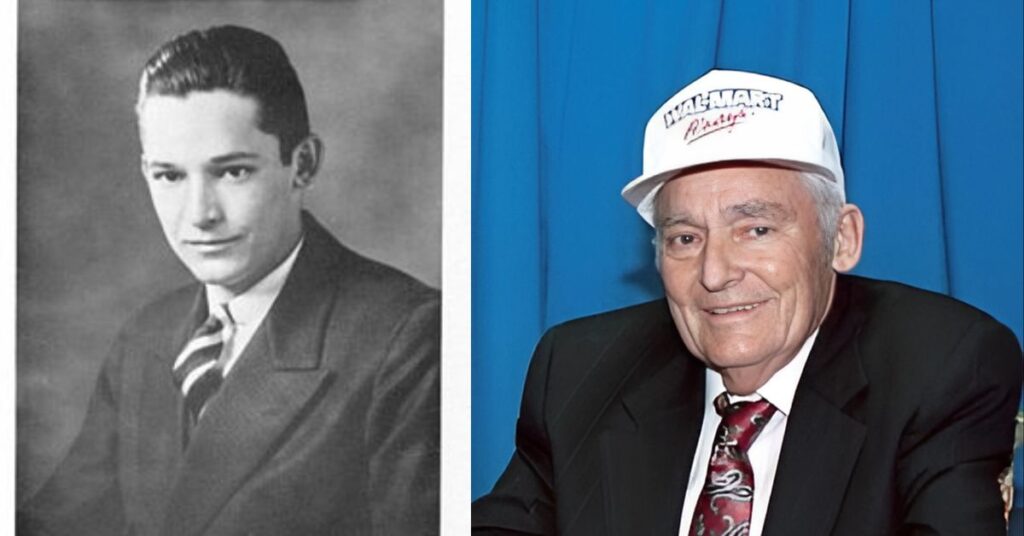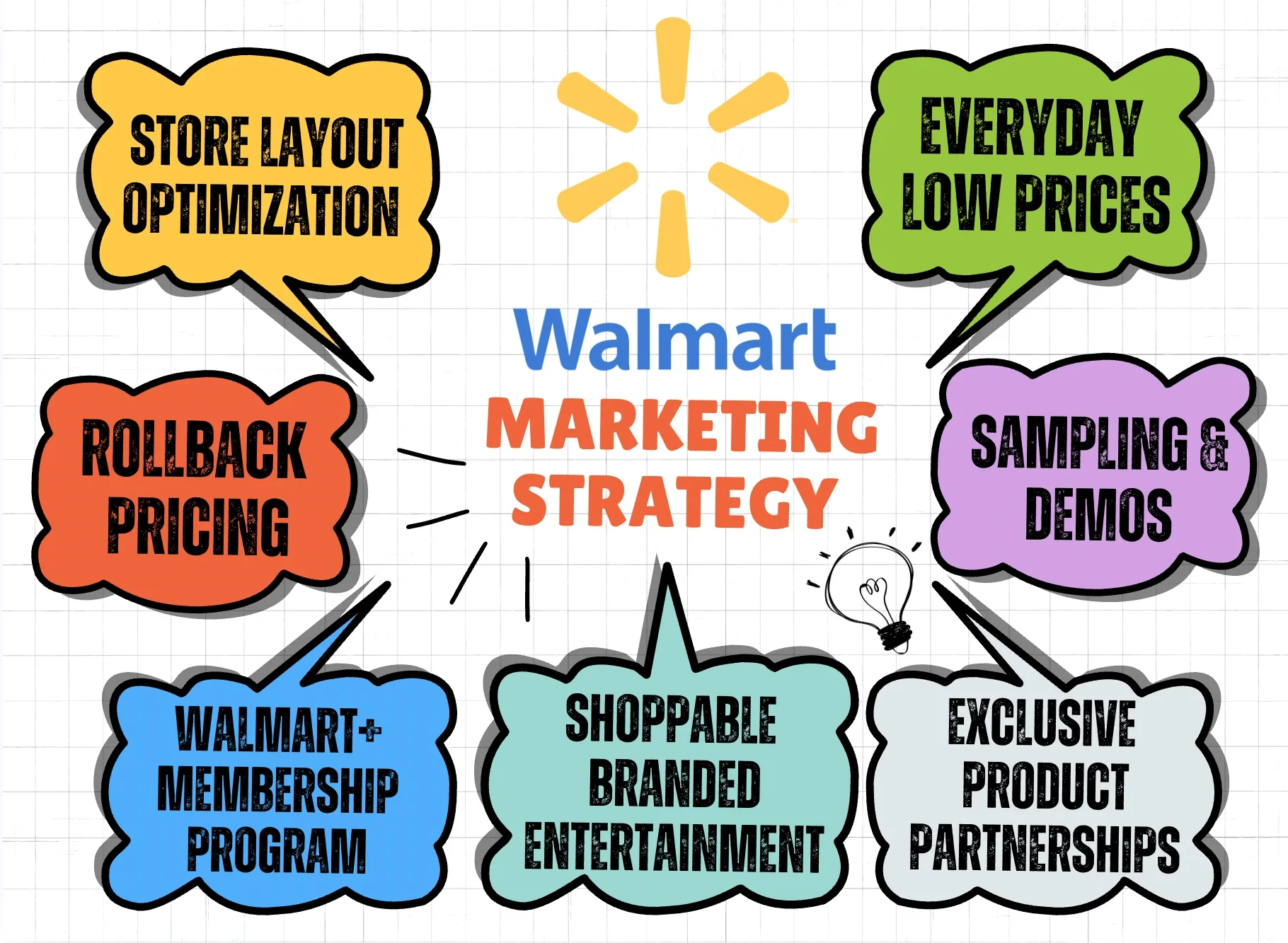1. Introduction
Walmart is an American multinational retail which is a large retail corporation known for its diverse range of products, including groceries, clothing, electronics, and home goods, and is recognized for its low prices. From its beginning as a single discount store in Rogers, Arkansas, Walmart has grown into a retail titan that touches the lives of millions around the globe every day. Founded in 1962 by Sam Walton, a visionary entrepreneur with a simple but powerful mission to offer customers the lowest possible prices and Walmart revolutionized how people shop and how stores operate.
Walton’s focus on underserved rural communities, combined with groundbreaking logistics, supply chain mastery, and a customer-first mindset, allowed Walmart to outpace competitors and reshape the retail landscape. Over six decades, Walmart expanded beyond American borders, embracing new markets, adapting to cultural differences, and pioneering digital transformation to meet the demands of the 21st century shopper. Walmart’s main promise to its customers is “Every Day Low Prices” (EDLP). This means they try to offer the lowest possible prices on all their products, all the time. They have over 10,500 stores and clubs in 19 countries and also have a strong online presence through their websites and apps.
Walmart uses a combination of physical stores and online shopping (called “omnichannel” retail) to reach customers. You can go into a store, shop online for delivery to your home, or even order online and pick up your groceries at the store. They are constantly using technology, like data analysis and AI, to understand what customers want and to make their operations even more efficient. This is the story of Walmart’s extraordinary journey, an inspiring tale of innovation, ambition, and unstoppable growth that changed retail forever.
2.Origins and Vision of Sam Walton

Walmart started because of one very driven and smart man named Sam Walton. He was born in 1918 in Oklahoma, USA, and grew up during tough economic times, which probably taught him a lot about saving money and being resourceful. Walton grew up during the hardship of the Great Depression, where every penny mattered. These early life experiences shaped his thinking and built the foundation for a retail revolution.
2.1.Sam’s Early Experience and The Spark of an Idea
Before starting Walmart, Sam had a lot of experience in retail. He worked at J.C. Penney, a department store, and later owned several “Ben Franklin” variety stores (which were like old-fashioned dollar stores). He was always a keen observer and a hard worker. After finishing college with a degree in economics, Sam joined the U.S. Army during World War II. Once he returned from service, he began working in retail. In 1945, with a small loan and support from his father-in-law, he bought a variety store in Newport, Arkansas. It wasn’t anything fancy, but Sam saw it as the perfect place to test his ideas.
He noticed something important that most of the big stores were in big cities, and people in smaller towns often paid more for things or had limited choices, also customers always looked for better prices. He realized that people were more likely to shop in a store where they could save money. He also saw how discount stores were starting to pop up, offering lower prices than traditional shops.
He believed that he could bring this “discount” idea to smaller towns, even though many people told him it wouldn’t work but he was strict on his believe. So, he started buying products in large amounts at lower costs and selling them for less than other stores. This way, more people came to his shop, and even with lower prices, he earned more because he sold more.
Sam often visited his competitors to see what they were doing right or wrong. He took notes, learned from their mistakes, and made changes in his own store. He was not afraid to try new ideas, even if they were different from what others were doing. Also he noticed that many big stores were only in large cities, leaving people in small towns with fewer options. Sam thought, “Why not bring low-cost shopping to smaller towns?” This simple idea would later become the heart of Walmart’s success.
Sam also believed in building strong relationships with his employees and customers. He often spoke to them, asked for their feedback, and made them feel important. His friendly, down-to-earth style made people trust him and his store. These early experiences gave Sam the confidence to think bigger. They sparked the idea that would later become Walmart: a store that offers quality products at low prices for everyday people, especially in places where good options were hard to find.
2.2.Sam’s Big Visions
Sam Walton’s vision for Walmart was built on a few very simple, but powerful, ideas:
•”Every Day Low Prices” (EDLP): This was his core belief, having occasional sales, he wanted to offer low prices all the time. He figured if customers knew they could always get a good deal, they would come back regularly and buy more. This strategy was about making a smaller profit on each item but selling a huge number of items.
•Focus on the Customer: Sam always said, “There is only one boss: the customer.” He believed that everything Walmart did should be about serving the customer well, giving them what they wanted (good products, low prices, good service), and making their lives better by helping them save money.
•Respect for his “Associates” (Employees): Sam treated his employees like partners, calling them “associates.” He believed that if he shared profits with them and respected them, they would work harder and be more dedicated to the company’s success. He encouraged them to come up with ideas and made them feel like they were part of something big.
•Efficiency and Frugality: Sam was known for being very careful with money, both his own and the company’s. He always looked for ways to cut costs – whether it was in transportation, store operations, or buying products – so that he could keep prices low for customers. He famously flew his own small plane to visit stores to save money and stay connected.
•Constant Learning and Experimentation: Sam was never afraid to try new things or to learn from his competitors. He would visit other stores, even on family vacations, to see what they were doing well and what he could improve in his own stores. He was willing to “swim upstream” and do things differently if he thought it would benefit his customers.
2.3. Sam’s Club
Sam’s Club was established on April 7, 1983 and is a big retail chain in the United States, owned by Walmart. It’s famous for being a “warehouse club” where you can buy things in large quantities at discounted prices. He saw the success of other warehouse clubs like Price Club and decided to enter that market, applying his own principles of low prices and efficiency. It was originally called “Sam’s Wholesale Club” but later shortened to “Sam’s Club.”
The most important thing to know about Sam’s Club is that people need to be a member to shop there. They need to pay an annual fee (there are different levels of membership) to get access to their stores and online deals. This membership fee is a key part of their business model, as it helps them offer lower prices on products.
3.Walmart’s Expansion Across the United States

After the grand opening of the first Walmart in Rogers, Arkansas, in 1962, it quickly became clear that Sam Walton’s idea was more than just smart, it was revolutionary. He prove that how a smart business idea worked because of good planning, and a lot of hard work can turn a local store into a national giant. Shoppers quickly embraced the store’s low prices, wide variety, and friendly atmosphere. Encouraged by early success, Walton began expanding carefully but strategically across the southern United States. Walmart didn’t chase large cities, it focused on small towns and rural areas that big chains often ignored.
3.1.The Early Years (1960s-1970s): Staying Close to Home, But Growing Fast
In the beginning, Walmart didn’t look like a company aiming to conquer the world. It started small, focused, and local. But even in those early days, from the 1960s to the 1970s, Walmart laid the foundation for what would become one of the greatest business success stories in history.
•Arkansas First: After the first Walmart store opened in Rogers, Arkansas, in 1962, Sam Walton had a simple but powerful idea, open more stores in neighboring small towns, keeping them close to home. Other chains that expanded into large cities, Walmart stayed rooted in the rural South serving the communities that others often ignored. This tight-knit store network became a key strategy. It allowed Walmart to maintain strong control over operations while building loyalty within local communities. By keeping stores close to each other, Walmart was able to:
- Communicate quickly between locations
- Deliver products faster and cheaper
- Manage stores more efficiently
•Small Towns Were Key: In the 1970s, while Walmart was still mostly in the southern U.S., it was already investing in technology that other companies wouldn’t touch for years. Sam Walton understood that information was power, and he wanted to use it to make better decisions. Other big retailers who focused on large cities, Sam saw opportunity in small, rural towns.
He believed these towns were often underserved and would appreciate having a store with low prices and a wide selection. Walmart began using computers to track inventory, analyze sales, and forecast trends. It may sound simple today, but at the time, it was cutting-edge. These early systems helped managers know what to restock, when to order, and how to meet customer demand all without wasting money.
Read More: How RFL Group Revolutionized Industrial Growth and Local Manufacturing in Bangladesh?
•Building a Strong Foundation: During this time, Walmart also started building its own distribution centers. These are like giant warehouses that efficiently send products to all the stores. This was a crucial step because it allowed Walmart to control its costs and get products to stores faster than competitors. They also started using early computer systems to track what was selling, which was very advanced for the time.This was a bold move most retailers still relied on third-party transport. This system allowed Walmart to:
- Restock stores faster than competitors
- Keep inventory levels balanced
- Reduce operating costs
•Store Count and Growth: By the end of the 1970s, Walmart had:
- 276 stores
- Sales of over $1 billion annually
- Thousands of employees, mostly from the communities they served
3.2.Becoming a Household Name (1990s)
By the time the 1990s arrived, Walmart was no longer just a Southern retail success, it had grown into a national phenomenon. What began as a single-store operation in rural Arkansas had now evolved into a brand recognized and trusted across the country. With every passing year, Walmart was becoming a household name in the United States.
•Dominating the U.S. Retail Landscape: In the early 1990s, Walmart officially became the largest retailer in the United States, a title that marked a major milestone in the company’s journey. The company expanded aggressively, entering new states year after year. By 1995, Walmart had a presence in every continental U.S. state, making it virtually unavoidable in the American shopping experience.
Families across the country began turning to Walmart for everything school supplies, groceries, home goods, clothing, electronics, and more. The brand was no longer regional. It was national. And for many Americans, a weekly trip to Walmart became a regular part of life.
This expansion was more than just about opening stores. Walmart’s powerful distribution network, efficient inventory systems, and cost-cutting culture helped it offer everyday low prices in both big cities and small towns. No matter where you lived, Walmart delivered value and that made it a favorite among working-class and middle-class shoppers.
•The Power of the Supercenter: One of the biggest drivers of Walmart’s 1990s success was the rise of the Walmart Supercenter. First introduced in 1988, this store format combined a traditional Walmart (offering clothing, home goods, electronics, etc.) with a full-service grocery store, all under one massive roof.
By the 1990s, the Supercenter model had become Walmart’s primary growth engine, completely transforming how people shopped. No longer did families need to visit separate stores for food and household goods. At the Supercenter, they could get it all done in one convenient trip. This format allowed Walmart to:
- Tap into the grocery market, one of the most frequent shopping needs
- Attract more foot traffic from daily and weekly shoppers
- Offer customers more convenience, savings, and time-efficiency
•A Decade of Unstoppable Growth: Throughout the 1990s, Walmart’s numbers were staggering:
- Thousands of stores opened nationwide
- Millions of employees hired across every state
- Billions in revenue year after year
3.3. A Trusted Name in Every Home
Walmart was no longer just the biggest retailer, it had become a part of American life. Whether people needed groceries, back-to-school clothes, a new TV, or holiday gifts, Walmart was the first name that came to mind. The 1990s marked the moment when Walmart didn’t just cover the map, it won the hearts of millions of households. With unbeatable convenience, lower prices, and nationwide reach, Walmart had completed its transformation from a local discount store into an American retail legend.
4.Technological Innovation and Supply Chain Mastery

Walmart’s ability to offer “Every Day Low Prices” and have everything you need usually boils down to two huge strengths: their smart use of technology and their amazing supply chain. Think of these as the hidden engines that power the whole operation. It’s success is not just about having thousands of stores or low prices and it’s also about what happens behind the scenes. From the very beginning, Sam Walton understood that smart business wasn’t only about selling, it was about managing how products move, how data is used, and how technology supports efficiency. These ideas led Walmart to build one of the most advanced supply chains in the world and it changed the face of modern retail forever.
4.1.Early Adoption of Technology
Long before many of its competitors, Walmart invested heavily in computer systems and data-driven decisions. In the 1980s and 1990s, while other retailers were still doing manual inventory checks, Walmart was already using barcode scanners and digital sales tracking systems. They used them for things like:
•Tracking Sales: Knowing exactly what was selling and where, in real-time. This helped them understand what customers wanted.
•Managing Inventory: Keeping track of every single item, so they knew what to reorder and when. This prevented shelves from being empty or stores from having too much of something that wasn’t selling.
•Payroll and Reports: Making sure employees were paid and getting quick updates on how each store was doing.
•Barcode Scanners (The Checkout Revolution): Walmart was one of the first to widely use UPC barcodes (those black and white lines you see on products) and Point-of-Sale (POS) systems at checkout.
4.2.Satellite Systems and Real-Time Tracking
In the 1980s, Walmart built its own private satellite communication system. This was a huge investment but allowed their headquarters to talk to every single store instantly, for:
•Voice and Data: Quick communication about sales, stock, and problems.
•Video: Even allowing Sam Walton to speak directly to all store managers at once. This created a strong company culture and ensured everyone was on the same page.
•Data Analysis (Predicting What You Want): With all this information coming in, Walmart became very good at “big data”. They analyze huge amounts of sales data to:
•Forecast Demand: Predict what products will be popular and when (e.g., more umbrellas before a rainy forecast, more hot dogs before a holiday weekend).
•Optimize Pricing: Decide the best prices to attract customers while still making a profit.
•Personalize Shopping: With online shopping, they use AI to suggest products you might like based on your past purchases or what similar customers bought.
4.3.Modern Tech (Robots, AI, Drones)
In more recent years, Walmart has embraced big data, artificial intelligence (AI), and machine learning to stay competitive in the digital age. Today, Walmart continues to innovate and they’re using:
•Robots in warehouses to sort and move products faster.
•AI (Artificial Intelligence) for things like optimizing delivery routes and helping customers with chatbots.
•Drones for super-fast deliveries of certain items in some areas.
4.4. How they get stuff from factories to your basket
This is where Walmart truly shines. Their supply chain is famous for being incredibly efficient, like a super-oiled machine.
•Distribution Centers (The Heart of the System): Instead of sending products directly from thousands of factories to thousands of stores, Walmart built a network of massive distribution centers (DCs). These are giant warehouses strategically located.
•How it Works: Products from many different suppliers arrive at a DC. From there, products are sorted and loaded onto Walmart’s own trucks, which then deliver to multiple stores in the surrounding area.
•Efficiency: This saves huge amounts of money and time compared to individual deliveries to each store.
•Cross-Docking (No Sitting Around): This is a clever technique. Instead of storing items in the distribution center for a long time, products are quickly moved from incoming trucks directly to outgoing trucks heading to stores.
•Benefit: Less storage time means less money spent on warehousing, less chance of damage, and faster delivery to stores.
•Direct Relationships with Suppliers: Because Walmart buys such huge quantities, they often deal directly with manufacturers instead of going through middlemen.
•Bargaining Power: This gives them strong power to negotiate lower prices for the products they buy, which then helps them offer lower prices to you.
•Sharing Data: Walmart shares sales data with its suppliers. This helps suppliers know exactly how much to produce and when to send it, making the whole process smoother and more efficient for everyone.
5.Stepping into the Global Arena
In 1990, Walmart had already become the undisputed leader of American retail. It had grown so big in the U.S. that it needed new places to grow. The American market was becoming “saturated,” meaning there were Walmart stores almost everywhere they could profitably go. To keep growing, they had to look for new customers in other countries. The company believed that customers everywhere, whether in Canada, China, or Chile wanted good products at low prices. Walmart had the systems, the technology, and the strategy to make it happen. All it had to do was learn how to adapt to different cultures, economies, and shopping habits.
5.1. Walmart’s First Steps to Abroad
•Mexico (1991): Walmart’s very first international store opened in Mexico City in 1991. This was a smart choice because Mexico is right next door to the U.S., making it easier to manage and transport goods. They often started with a joint venture, meaning they partnered with a local Mexican retail company (like Cifra) to learn about the market and share the risk.
•Canada (1994): Soon after, in 1994, Walmart moved into Canada by actually buying an existing chain of stores called Woolco. This was a quicker way to get many stores up and running at once.
They chose neighboring countries (Mexico and Canada) first. They used different entry strategies (joint venture in Mexico, acquisition in Canada) to suit the specific market conditions. Their main goal was to bring their successful U.S. model of low prices and efficient operations to new customers, while also learning how to adapt to international differences.
5.2. How They Expanded: Different Approaches
When Walmart decided to expand globally, they didn’t have a “one-size-fits-all” approach. They used different methods, often choosing the best way to enter a country based on its unique rules, market, and competition.
•Buying Existing Companies: This is when Walmart simply buys out an existing retail company in another country. It’s like buying a whole bunch of ready-made stores with their customers, employees, and supply chains already in place. They do it for, instant market entry, local knowledge, reduced competition. As, Canada (1994) (Walmart bought the Woolco chain of stores), United Kingdom (1999) (Walmart acquired Asda, a major British supermarket chain), South Africa (2011) (they bought a majority stake in Massmart).
•Partnering with Local Companies: This is when Walmart teams up with a local company in another country to create a new business together. They share ownership, profits, and also the risks and responsibilities. They do it because, navigating local rules, shared risk, local expertise. As, Mexico (1991) (Walmart’s very first international move was a joint venture with Cifra, a large Mexican retailer. This partnership was key to their early success there), India(due to foreign direct investment (FDI) regulations, Walmart initially entered India through a joint venture, focusing on wholesale cash-and-carry formats).
•Building New Stores from Scratch: This is the most direct approach. Walmart buys land and builds entirely new Walmart stores from the ground up in a foreign country, just like they did when they started in the U.S. They do it because of full control and tailored to needs.
5.3. Learning Along the Way (Adjusting to New Cultures)
•Local Tastes: People in different countries have different preferences. For example, in China, customers prefer to buy fresh meat and fish, not pre-packaged. Walmart had to learn to offer these things.
•Shopping Habits: In some cultures, people shop more frequently at smaller, local stores instead of big supermarkets for weekly hauls. Walmart had to adapt its store sizes and offerings.
•Competition: They faced strong local competitors who knew their markets very well.
•Cultural Differences: Things like how employees are managed, how suppliers are dealt with, or even what items are placed at the front of the store, all needed to be adjusted for local culture. Walmart even faced challenges in countries like Germany and eventually withdrew because they struggled to adapt.
6.Marketing Strategy: Building a Brand on ‘Everyday Low Prices’

Walmart’s rise to retail dominance wasn’t built on flashy ads, celebrity endorsements, or luxury branding. Instead, it was built on one powerful promise, “Everyday Low Prices.” This simple yet bold message became the backbone of Walmart’s brand identity and it connected deeply with millions of value-conscious shoppers across the world.
6.1. What Does ‘Everyday Low Prices’ Really Mean?
“Every Day Low Prices” (EDLP) is a core strategy, especially for retailers like Walmart. Many stores that constantly have “sales,” “discounts,” or “limited-time offers” to attract shoppers, Walmart aims to have a low price on its products all the time. People don’t have to wait for a special event or clip coupons to get a good deal. The price will see on itself, today is generally the low price you’ll see tomorrow, next week, or next month. This strategy creates a sense of predictability and trust.
Read More: Microfinance Leads Bangladesh’s Fight Against Poverty
Shoppers know that when they go to Walmart, they can consistently find items at a competitive price without worrying that it might be cheaper somewhere else next week, or that they missed a flash sale. This simplifies the shopping experience. Walmart makes its money by selling a huge volume of products. Even if the profit margin (the difference between what they pay for an item and what they sell it for) on each individual item is small, selling millions of those items adds up to a very large overall profit.
6.2. How Walmart Made It Work
Walmart’s EDLP strategy wasn’t just a slogan, it was supported by a powerful business model that made low prices possible, including:
•Efficient supply chains
•Strong relationships with suppliers
•Buying in bulk to reduce costs
•Controlling operating expenses tightly
6.3. Simple, Clear, and Honest Advertising
Walmart’s marketing stood out by being straightforward and down-to-earth. Instead of glamorous campaigns, Walmart focused on:
•Highlighting low prices
•Showing real families and real savings
•Sharing community stories and employee pride
TV ads, print materials, and later online promotions all focused on what mattered most to its customers—affordability, trust, and accessibility. Famous taglines like:
•“Save Money. Live Better.”
•“Always Low Prices. Always.”
6.4. Price Rollbacks: A Shopper’s Favorite
Rollback means a temporary reduction in the price of an item. One of Walmart’s most recognizable marketing tools is the “Rollback” program, where prices on popular items are reduced even further for a limited time. The familiar yellow smiley face icon quickly became a symbol of extra savings.
Rollback campaigns created excitement, brought more foot traffic, and reminded shoppers that Walmart is constantly working to lower prices even more than usual. It’s not a permanent price drop. The price might go back up after a certain period (weeks or months).While Walmart already aims for “Every Day Low Prices,” a rollback signifies an even lower price for a limited time.
6.5. In-Store Marketing and Experience
Walmart also focused on the in-store experience as a marketing tool:
•Clear signs showing prices and promotions
•End-of-aisle displays featuring best deals
•Friendly greeters at the entrance
•Clean, organized layout for fast shopping
6.6. Digital Marketing and Social Media
As shopping habits changed, so did Walmart’s marketing strategies. The company embraced digital platforms to:
•Promote online deals and seasonal campaigns
•Share helpful videos, recipes, and back-to-school tips
•Engage with communities on platforms like Facebook, Instagram, and YouTube
•Send personalized offers through its mobile app and email programs
7.Walmart’s Digital Transformation and E-commerce
In a world that is moving rapidly toward digital shopping, Walmart knew it had to adapt or fall behind. Once known only for its massive physical stores, Walmart has spent the past two decades transforming itself into a digital powerhouse, embracing online shopping, new technologies, and a smarter, more connected customer experience. This digital evolution has allowed Walmart to compete with e-commerce giants like Amazon, while continuing to serve millions of loyal in-store shoppers.
7.1. Why Digital Transformation?
•The Amazon Challenge: The biggest reason was the rise of Amazon. Amazon started as an online-only store and quickly became dominant. Walmart couldn’t ignore this. They realized that if they wanted to keep “saving people money,” they had to be where people were shopping – which was increasingly online.
•Changing Shopper Habits: People wanted convenience. They wanted to shop 24/7 from their couch, have items delivered, or pick them up quickly. Walmart had to adapt to these new demands.
•Speed and Efficiency: Digital tools could make their already efficient supply chain even faster and smarter.
7.2. Walmart’s Approach to E-commerce
Walmart didn’t just build a website; they tried to blend their physical stores with their online presence. This is often called “Omnichannel Retail.” It had a website fairly early on (around the late 1990s), but initially, they didn’t invest enough in it. They didn’t fully believe online shopping would be as big as it became. This was a missed opportunity they later had to catch up on.
•Improved Website and App: They heavily redesigned Walmart.com and their mobile app to make them easy to use, fast, and visually appealing. They added features like personalized recommendations (like Amazon), easy search, and quick checkout.
•Walmart Marketplace: This was a big move! Like Amazon, Walmart opened its website to third-party sellers. This means other businesses can sell their products on Walmart.com. This instantly expanded the variety of products available without Walmart having to buy and stock everything themselves.
•”Buy Online, Pick Up In-Store” (BOPIS): This became a huge success and leveraged Walmart’s biggest advantage: its massive number of physical stores. You can order groceries or other items online, and a Walmart associate will gather them for you, ready for quick pickup at a designated spot outside the store or inside. This offers speed and convenience without delivery fees.
•Grocery Pickup and Delivery: Walmart became a leader in online grocery. You can order all your food online for either curbside pickup or home delivery. This was especially critical during the recent global pandemic, as many people relied on these services.
•Walmart+ and Subscription: To compete with Amazon Prime, Walmart launched “Walmart+”. This membership offers benefits like free unlimited deliveries, discounts on fuel, and mobile Scan & Go (allowing you to scan items with your phone and pay without waiting in line).
•Leveraging Stores as “Fulfillment Centers”: Walmart’s thousands of stores aren’t just places to shop; they’re also used as mini-warehouses for online orders. This allows them to fulfill online orders faster and cheaper, especially for local deliveries.
•AI (Artificial Intelligence): To predict what customers want, optimize delivery routes, and improve customer service.
•Automation/Robotics: In warehouses to speed up sorting and packing.
•Last-Mile Delivery: Experimenting with various delivery methods, including their own drivers, partnerships with delivery services (like DoorDash), and even drones in some areas for super-fast delivery of smaller items.
8.Post-Pandemic Strategy and Future Outlook
The COVID-19 pandemic reshaped the global economy, disrupted supply chains, and transformed how people live, work, and shop. For Walmart, the crisis was both a massive challenge and a defining moment. As the world adjusted to new realities, Walmart responded with bold strategies, accelerated innovation, and a renewed focus on the future. Their Post-Pandemic Strategy is all about learning from those changes and preparing for the future.
8.1.How Walmart Adapted During the Pandemic
•Supercharged Online Shopping: When people couldn’t or wouldn’t go to stores as much, Walmart pushed its online grocery pickup and delivery services into overdrive. They quickly expanded these options to thousands of stores, hired lots of extra staff for picking and packing online orders, and even used their regular stores to fulfill online orders faster.
•Safety First: They quickly put in place safety measures like limiting the number of shoppers in stores, requiring masks (when mandated), increasing cleaning, and setting up special shopping hours for seniors.
•Keeping Shelves Stocked: With huge demand for certain items (like toilet paper and cleaning supplies), Walmart used its powerful supply chain to move products to where they were needed most, even chartering their own ships to avoid port delays.
•Contactless Options: Features like “Scan & Go” (scanning items with your phone to pay) and curbside pickup became super popular because they minimized contact.
8.2.Walmart’s Post-Pandemic Strategy
The COVID-19 pandemic significantly accelerated changes in how people shop, pushing many more consumers online and creating new expectations for convenience and safety. Walmart, as a retail giant, had to quickly adapt, and its post-pandemic strategy is a direct response to these shifts, aiming to maintain its leadership in a transformed retail landscape.
•Blending Online and In-Store: This is the core. Walmart wants to make it seamless for customers to shop however they prefer. Whether it’s shopping in a physical store, ordering online for delivery, or using curbside pickup, they want the experience to be smooth and convenient.
•Supercharging Online Pickup & Delivery: The pandemic made online grocery a massive trend. Walmart quickly expanded its curbside pickup (where you order online and workers bring it to your car) and home delivery services to thousands of stores. They’re continuously refining these to be faster and more reliable.
•Walmart+ Membership: To compete with services like Amazon Prime, Walmart pushed its Walmart+ membership. This offers benefits like free unlimited deliveries, discounts on fuel, and mobile Scan & Go (allowing you to scan items with your phone and skip checkout lines). This builds loyalty and encourages customers to use all of Walmart’s services.
•Leveraging Stores as Mini-Fulfillment Centers: Walmart’s vast network of physical stores is a huge asset. They’re increasingly using these stores not just for in-person shopping, but also as local hubs to quickly fulfill online orders for delivery or pickup, making the “last mile” of delivery faster and cheaper.
•AI and Data: Walmart is using Artificial Intelligence to get even smarter about what customers want, when they want it, and how to stock shelves efficiently. This helps them predict demand, optimize pricing, and personalize the online shopping experience.
•Robotics in Warehouses and Stores: To increase efficiency and speed, Walmart is investing heavily in automation. This means more robots in their large distribution and fulfillment centers to sort and move products, and even robots in stores to help with tasks like scanning shelves for out-of-stock items.
•Automated Fulfillment Centers: They are building new, highly automated facilities specifically designed to process online orders at incredible speeds, preparing for even greater e-commerce demand.
•Delivery Innovations: Beyond traditional trucks, Walmart is exploring and expanding new delivery methods like drone delivery in select areas for very fast delivery of smaller, urgent items.
•Focus on Profitability: While innovation is important, recent strategies suggest a focus on making their digital operations profitable. For example, they are aiming for their U.S. e-commerce business to be profitable.
•Re-evaluating Diversification: Walmart has recently made some strategic adjustments, such as closing Store No. 8 (their tech incubator that explored futuristic retail concepts) and closing 51 Walmart Health clinics. This indicates a shift towards concentrating on their core retail strengths and operational efficiency rather than experimental projects or ambitious forays into other industries that weren’t immediately profitable.
•Optimizing Workforce: They are also making changes to their corporate workforce, including some layoffs and asking many remote employees to relocate to central office hubs like Bentonville. This is aimed at streamlining operations and potentially improving collaboration and cost efficiency.
8.3. Future Outlook of Walmart
•Faster Pickup & Delivery: Expect even quicker and more reliable ways to get your online orders. This means more options like same-day delivery, Express delivery (in as little as 30 minutes for some items), and even faster curbside pickup.
•Stores as Hubs: Their thousands of physical stores won’t just be places to shop. They’ll increasingly act as mini-warehouses for online orders, making local deliveries and pickups much faster and cheaper.
•Artificial Intelligence (AI) Everywhere: AI is a huge part of their future. It will be used to, predict what you want, personalize your shopping, Help Employees.
•Robots and Automation: Expect more robots and automated systems in their giant warehouses and even in the back rooms of stores. These help move and sort products faster, reduce errors, and free up human workers for more customer-focused tasks.
•Delivery Innovations: Beyond regular delivery vans, they’re actively exploring and expanding things like drone delivery for quick, small orders in certain areas.
•Focusing on Sustainability: Walmart is putting a big emphasis on being more environmentally friendly. This includes ambitious goals like becoming a “regenerative company” and aiming for zero emissions across its global operations by 2040. This means using more renewable energy, electrifying their delivery fleet, and reducing waste. This aligns with what more and more customers care about.
•Continued International Growth: While the U.S. remains crucial, they will continue to look for growth opportunities in key international markets where they have a strong presence, always adapting their approach to local tastes and customs.
9.Conclusion
Walmart’s journey, from Sam Walton’s simple idea of “Every Day Low Prices” in a small town to a global giant, is a powerful story of constant change. In 1962, as a single store in small-town Arkansas has grown into a global retail empire that touches the lives of hundreds of millions of people every day. It isn’t just sticking to its old ways. It’s embracing the future with open arms, powered by technology that makes shopping easier than ever.
Sam Walton’s belief in serving the underserved, to its expansion across America, and its bold steps into international markets, Walmart has continuously reshaped the retail industry. It has mastered the art of low prices, built one of the world’s most advanced supply chains, and proven that smart use of technology can change the game for businesses of any size.
They’re making their stores and online shopping work together perfectly, so you can shop however, whenever, and wherever you want. And it’s not just about saving money; Walmart is also focused on being a more sustainable company, showing they care about the planet and its people.
Reference
Wikipedia
Walmart
Food & Wine
Supply Chain Dive
Corporate Walmart
CBS News
Newsweek
SupplyPike
Retail TouchPoint
Arkansas Business
Time Magazine
Forbes
Walmart Career
PBS
History Timelines
CBC
Share via:


















